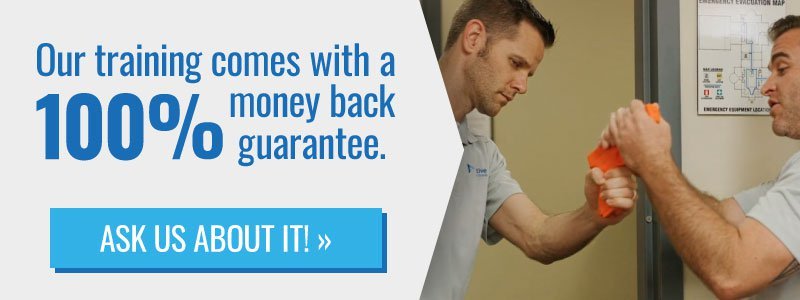 For some organizations, such as South Carolina Public Schools, Active Shooter Training Drills are mandatory. They're a task on a to-do list and essentially a box that every school administrator is relieved to check off.
For some organizations, such as South Carolina Public Schools, Active Shooter Training Drills are mandatory. They're a task on a to-do list and essentially a box that every school administrator is relieved to check off.
Depending on what company you work for, Active Shooter Response Training may be mandatory as well. Many organizations are now requiring on-site training, video training, or some form of blended learning for their entire workforce.
It's not a small task. In both scope and importance, Active Shooter Training is a major undertaking. So, how can you be sure you're doing it right? In other words, how do you provide training that's not forgotten as quickly as it's taught?
In this article, we'll point out training strategies that make an Active Shooter Training course successful, but first, we'll start by identifying some of the mistakes that could be undermining the training you're offering your team.
Warning signs that you're training just to check a box
You're looking for the cheapest training option.
We understand that every company and organization operates on a budget. It's possible that you're not even the person who determines the budget, and yet you've been given the responsibility of finding Active Shooter Response Training that's either free or so unbelievably affordable that it might as well be free.
If this is the scenario you find yourself in, we challenge you to do your research before selecting a training program. If you're serious about your research, you may be able to come up with a convincing proposal for your boss, arguing that training at a higher cost comes with higher value.
Ultimately, it goes back to the question we ask our class participants at every training class: What is the value of effective training, and what is the cost of ineffective training?
You'd rather email your team an inconclusive training video than take time out of the week for a training course.
If you're a business owner, then you're probably adept at working efficiently. However, if you're evaluating Active Shooter Response Training from an efficiency standpoint, then you're putting yourself and your team in a precarious position. Why? Because the most efficient training is going to be the least effective.
Ineffective training often comes in the form of a short 5- to 7-minute training video that fails to provide any real guidance or comprehensive instruction. In that amount of time, a video will almost certainly plant fear in the minds of your team, but it will hardly skim the surface when it comes to learning to respond in an actual crisis.
Something as in-depth as Active Shooter Response Training was never meant to be judged on efficiency. It was intended for efficacy. Who cares how efficiently your team flew through a 7-minute training video if they're not effectively prepared to actually respond in an emergency? If your approach to training is more about efficiency than effectiveness, then that's a clear sign you're just training to check a box.
You've tasked your HR department with compiling a training manual for the company to skim and sign off on.
Those who don't use videos for Active Shooter Response Training will often opt for training manuals. We'd argue that a training manual is perhaps the least effective way to train a team in active shooter response. Not only do training manuals fail to provide hands-on training opportunities, but they also lack the visual aspect that a training video course provides. It's difficult to fully grasp concepts such as tourniquet application or wound packing without actually seeing them done.
Even if the material in a training manual is easily understood by the reader, the biggest problem presents itself when it comes to recall. Reading and comprehension is one thing; however, reading and responding in a high-stress situation is quite another.
Confirmation that you're training effectively
Your training is hands-on (or at least blended).
There's proven value in hands-on training for active shooter response. Having the opportunity to physically practice certain skills will develop muscle memory that is invaluable in a crisis situation. When your brain can't recall a learned response, your body will, increasing your chances of survival.
For larger companies and organizations that cannot offer hands-on training to their entire team, we recommend blended learning. This means that part of your team will take an on-site training class that offers hands-on learning opportunities, and the remainder of your team will complete the Active Shooter Response Video Curriculum. Unlike many training videos, our video curriculum is in-depth, comprehensive, and the foundational elements of both training formats are the same. Another advantage of the video courses is that they can be repeated, giving your team the opportunity to watch and practice the skills and develop muscle memory just like those who took an on-site training class.
Your training is scenario-based.
One of the reasons we do on-site training for organizations is because we can have detailed discussions about active shooter scenarios based on your everyday location, specifically the layout of your building, business complex, campus, or office. During our training sessions, we help you visualize possible scenarios and then guide your critical thinking skills in developing an effective plan for survival.
Your training includes Emergency Medical Response.
Most Active Shooter Training opportunities lack the Emergency Medical Response component. This is a key part of ProActive Response Group's training. Not only do we train class participants on using lifesaving medical equipment, but we also offer Bleeding Control Kits that they can purchase and keep with them at home, in their cars, in their classrooms, or at the office.
Interested in learning more about effective Active Shooter Response Training and Emergency Medical Training? Contact us online, or give us a call at (888) 512-3530.
.png?width=499&height=133&name=Logo-menu%20(1).png)



